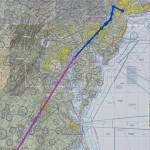 It was a steamy summer afternoon, the air filled with the acrid smell of smoke from the local forest fires made my leaving the historic city of Charleston, South Carolina for cooler weather more palatable. It was the last flight of my scheduled trip and I planned on getting to Newark early for dinner, but my plans where to be interrupted in many ways.
It was a steamy summer afternoon, the air filled with the acrid smell of smoke from the local forest fires made my leaving the historic city of Charleston, South Carolina for cooler weather more palatable. It was the last flight of my scheduled trip and I planned on getting to Newark early for dinner, but my plans where to be interrupted in many ways.
I was excited to get going because the weather was forecast to be good in Newark and there was only one large thunderstorm over our route in southern New Jersey which I didn’t think would cause much of a problem enroute. But like everything else that day it did not go as planned and I had to make alternate arrangements for both dinner and our flight path.
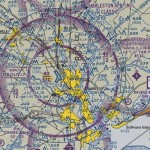 Prior to departing Charleston we were told there would be a short delay for spacing along the arrival to Newark. This is nothing out of the ordinary and happens almost every afternoon. A short twenty minute delay and we were climbing through cooler air leaving a smoke filled and steamy South Carolina behind us.
Prior to departing Charleston we were told there would be a short delay for spacing along the arrival to Newark. This is nothing out of the ordinary and happens almost every afternoon. A short twenty minute delay and we were climbing through cooler air leaving a smoke filled and steamy South Carolina behind us.
The cockpit finally began cooling off as we approached North Carolina and I was feeling fairly confident in our ability to get into Newark even if we had to hold since we had 40 minutes of extra fuel on board. That is about the time we received a call from ATC (Air Traffic Control) that we were cleared to Raleigh Durham and to begin slowing because we would be holding.
We were feeling quite relaxed with our situation since first we would be holding over an airport where we could stop for fuel and second we had extra gas. That relaxed feeling would soon disappear.
The first sign of trouble came when the controller gave us our expect further clearance time of 40 minutes from now. So much for our extra fuel. If we actually held that long we would have to declare minimum fuel (see article on when to declare minimum fuel). This is when I jokingly told the first officer that it would be highly unlikely that we would hold for that long this far from our destination.
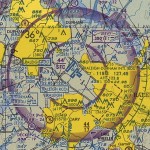 Holding over Raleigh Durham Airport, we had plenty of time to discuss our alternate plans. When flying a single engine piston I at all times have a landing spot and the closest airport in mind in case we need to land right away. This carries over to my flying twins and even an airliner. I always want to know where I am going if we have mechanical problems or an engine quits.
Holding over Raleigh Durham Airport, we had plenty of time to discuss our alternate plans. When flying a single engine piston I at all times have a landing spot and the closest airport in mind in case we need to land right away. This carries over to my flying twins and even an airliner. I always want to know where I am going if we have mechanical problems or an engine quits.
This helps me while flying IFR and in all environments, especially the situation we found ourselves in that day. I do one more thing for planning purposes when approaching busy airspace with the possibility of holding . I look at the enroute chart and pick alternates along the way and have a plan of action in my mind.
While looking at the chart I made a mental note of airports along the route and at what point I would go to that airport. For example, our new route was now from RDU to PEEDS intersection and the PHLBO2 to Newark. Along our route I noted the best places for us to get fuel. Of course if we held longer than expected our first stop would be Raleigh Durham.
The next alternative airports are ones I decided would be best both for safety but also in their ability to fuel us and have us underway quickly. As you can see based on our route below we picked alternative airports of Richmond, Baltimore, and then Allentown.
(click to enlarge images)
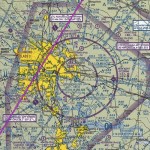
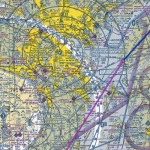

Thirty-five minutes after holding over Raleigh, the controller cleared us to continue on to Newark. The problem is now we had hardly any fuel for holding and the way things were going we probably would be holding again as we approached Newark.
Sure enough as we passed Philadelphia the controller told us to “expect holding and if we slowed now we may not need to hold for long”. Well this was not much of an option because by our estimation we had maybe 5 minutes or less of holding fuel.
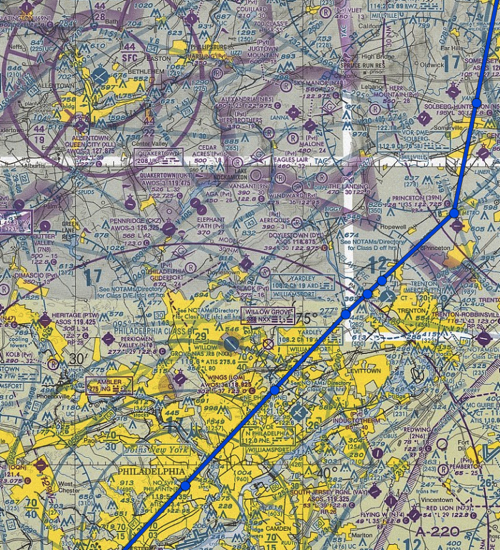
We slowed down to burn less fuel with our fingers crossed that we would be able to get into Newark. Shortly after slowing our hopes were dashed when the controller called to tell us to expect holding at Yardley and we were number six in line for the airport. As we checked our fuel we noticed that we didn’t quite have the fuel we thought we would so we decided to proceed to Allentown and get some gas.
On our way to Allentown luck would have it that the controller told us Newark could take us now if we wanted. Since we were getting low on fuel and could already see Allentown we decided to land and get fuel.
After adding fuel we picked up our clearance from ATC and flew back to Newark for what we hoped would be an uneventful flight, but that wasn’t in the cards for us.
As we headed to Newark we joked about how we filed Allentown as our alternate and that we probably wouldn’t need it because of all the extra fuel we took. We soon would realize how it was a good idea that we took the extra gas.
On final approach to Newark the controller accidentally put us too close behind a heavy aircraft and made us go around. After we climbed up to five thousand feet and prepared for our next attempt the first officer looked at me and said “they aren’t going to put us in line again are they?” I smiled and said “welcome to New York airspace, we will be in the air for at least another ten to fifteen minutes before they get us into Newark”.
We finally made it on the ground after this attempt and after pulling into the gate we talked about the flight coming to the conclusion you don’t really know what to expect when you get in the air and it is always good to have alternative airports in mind even if an alternate is not required.
Next time you are on a cross country flight I encourage you to always be vigilant and at all times know where you will go if you have a mechanical problem or the weather gets bad at your destination. During your initial training I hope your instructor made you divert to another airport while enroute.
If you don’t already do so, I hope you will use this example as a reason to have an alternative plan no matter how good the weather is. As you can see the weather was good for us but due to intense traffic and unforecast thunderstorms we had to divert to an alternate.
At all times while flying you should know exactly where you will go if you can’t continue the flight. If you can’t answer that question you should look for an airport and keep it in your mind until a better alternate plan becomes available. You should continue to revise your alternate plan as you fly.
As we all know, flying is a series of decisions and consequences. Make your decision process easier when confronted with unknown weather or mechanical difficulty by always having an alternate airport or field in mind at all times. Therefore, when you are presented with a problem that requires you to land you will be headed immediately towards a place to land and not have to look for one during a stressful situation due to weather or mechanical difficulty.
Safe Flying!
